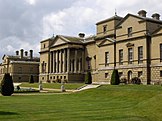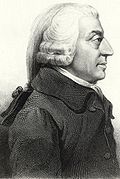Portal:The arts
T H E A R T S P O R T A L
The arts are a wide range of human practices of creative expression, storytelling, and cultural participation. They encompass multiple diverse and plural modes of thinking, doing, and being, in an extremely broad range of media. Both dynamic and a characteristically constant feature of human life, they have developed into innovative, stylized, and sometimes intricate forms. This is often achieved through sustained and deliberate study, training, and/or theorizing within a particular tradition, across generations, and even between civilizations. The arts are a vehicle through which human beings cultivate distinct social, cultural, and individual identities while transmitting values, impressions, judgements, ideas, visions, spiritual meanings, patterns of life, and experiences across time and space.
Prominent examples of the arts include:
- visual arts (including architecture, ceramics, drawing, filmmaking, painting, photography, and sculpting)
- literary arts (including fiction, drama, poetry, and prose)
- performing arts (including dance, music, and theatre)
They can employ skill and imagination to produce objects and performances, convey insights and experiences, and construct new environments and spaces.
The arts can refer to common, popular, or everyday practices as well as more sophisticated, systematic, or institutionalized ones. They can be discrete and self-contained or combine and interweave with other art forms, such as the combination of artwork with the written word in comics. They can also develop or contribute to some particular aspect of a more complex art form, as in cinematography. By definition, the arts themselves are open to being continually redefined. The practice of modern art, for example, is a testament to the shifting boundaries, improvisation and experimentation, reflexive nature, and self-criticism or questioning that art and its conditions of production, reception, and possibility can undergo.
As both a means of developing capacities of attention and sensitivity and as ends in themselves, the arts can simultaneously be a form of response to the world and a way that our responses and what we deem worthwhile goals or pursuits are transformed. From prehistoric cave paintings to ancient and contemporary forms of ritual to modern-day films, art has served to register, embody, and preserve our ever-shifting relationships to each other and to the world. (Full article...)
Featured articles -
Featured picture
Did you know...
- ... that the United States Class II 1804 Silver Dollar (pictured) is alleged to have been struck over a Swiss Shooting Thaler?
- ... that a heckling comb is used when hand processing flax to comb out and clean the fibers?
- ... that between 1970 and 1984 the WE Seal of approval program aided in an estimated US$100,000 in restitution being made to collectors of comics and other memorabilia victimized by mail fraud?
In this month
- 9 April 2000 – Jackie Evancho is born. At the age of 10, she becomes the youngest singer in history with a platinum album, O Holy Night.
- 10 April 1900 – Scottish soprano Mary Garden makes her professional debut singing the title role in Gustave Charpentier's Louise at the Opéra-Comique in Paris
- 11 April 1869 – Norwegian sculptor Gustav Vigeland, designer of the Nobel Peace Prize medal, is born near Halse og Harkmark
- 12 April 1937 – Abdülhak Hâmid Tarhan, an early 20th-century Turkish playwright and poet who was one of the leading lights of the Turkish Romantic period dies in Istanbul
- 23 April 1616 – William Shakespeare (pictured), often considered the greatest English playwright, dies in Stratford-upon-Avon at the age of 52
- 29 April 1968 – Hair, which defined the genre of the "rock musical", has its Broadway premiere at the Biltmore Theatre
News
- August 5: DaBaby Levitating remix losing US radio audiences after the rapper's comments on HIV/AIDS
- June 11: Taylor Swift's Evermore records biggest sales week of the year as it returns to No 1 on album chart
- May 27: Olivia Rodrigo's song good 4 u debuts at No 1 on US Billboard Hot 100 chart
- May 25: 'Rock and roll never dies': Italy wins Eurovision after 30 years
- February 10: Disney to shut down Blue Sky Studios, animation studio behind 'Ice Age'
Featured biography
Matthew Brettingham (1699–1769) was an 18th-century Englishman who rose from humble origins to supervise the construction of Holkham Hall, and eventually became one of the country's better-known architects of his generation. Much of his principal work has since been demolished, particularly his work in London, where he revolutionised the design of the grand townhouse. As a result he is often overlooked today, remembered only for his Palladian remodelling of numerous country houses, many of them situated in East Anglia. As Brettingham neared the pinnacle of his career, Palladianism began to fall out of fashion and neoclassicism was introduced, championed by a young Robert Adam. Brettingham was the second son of Launcelot Brettingham, a bricklayer or stonemason from Norwich, the county town of Norfolk, England. (Full article...)
Featured audio
Selected quote
| “ | Observe the accommodation of the most common artificer or daylabourer in a civilized and thriving country, and you will perceive that the number of people, of whose industry a part, though but a small part, has been employed in procuring him this accommodation, exceeds all computation. The woollen coat, for example, which covers the day-labourer, as coarse and rough as it may appear, is the produce of the joint labour of a great multitude of workmen. The shepherd, the sorter of the wool, the wool-comber or carder, the dyer, the scribbler, the spinner, the weaver, the fuller, the dresser, with many others, must all join their different arts in order to complete even this homely production. How many merchants and carriers, besides, must have been employed in transporting the materials from some of those workmen to others who often live in a very distant part of the country? How much commerce and navigation in particular, how many ship-builders, sailors, sail-makers, rope-makers, must have been employed in order to bring together the different drugs made use of by the dyer, which often come from the remotest corners of the world? What a variety of labour, too, is necessary in order to produce the tools of the meanest of those workmen! To say nothing of such complicated machines as the ship of the sailor, the mill of the fuller, or even the loom of the weaver, let us consider only what a variety of labour is requisite in order to form that very simple machine, the shears with which the shepherd clips the wool. The miner, the builder of the furnace for smelting the ore the feller of the timber, the burner of the charcoal to be made use of in the smelting-house, the brickmaker, the bricklayer, the workmen who attend the furnace, the millwright, the forger, the smith, must all of them join their different arts in order to produce them. | ” |
Categories
WikiProjects
Parent project
Descendant projects
Related portals
Things you can do
- Check the recent changes page for improvements, other changes, and vandalism to these articles
- Article requests: Requests articles (arts and entertainment)
- Deletion discussions: Listed at Wikipedia:WikiProject Deletion sorting/Arts
- Expand: check Visual arts stubs to expand
- Notability: Articles with notability concerns, listed at WikiProject Notability
- Requested pictures: Arts topics, requested pictures































